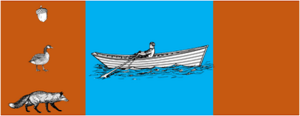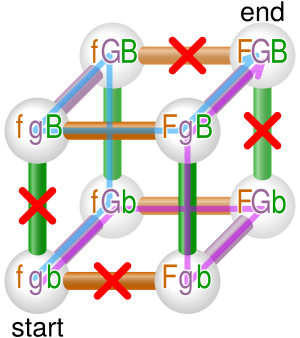Wolf, goat and cabbage problem facts for kids
The wolf, goat and cabbage problem is a famous river crossing puzzle. It's a very old puzzle, first written down around the 9th century!
The Puzzle Story
Once upon a time, a farmer went to the market. He bought a wolf, a goat, and a cabbage. On his way home, the farmer reached a river. He rented a small boat to cross it.
The problem was, the boat was tiny! The farmer could only carry himself and one of his purchases at a time. He couldn't take the wolf, the goat, and the cabbage all at once.
There was another big problem:
- If the wolf and the goat were left alone together, the wolf would eat the goat!
- If the goat and the cabbage were left alone together, the goat would eat the cabbage!
The farmer's challenge was to get himself and all three items safely across the river. How do you think he did it without anything getting eaten?
How to Solve It!
This puzzle can seem tricky at first, but there's a clever way to solve it! The key is realizing that you can bring things back across the river.
Here are the steps to solve the puzzle:
- Take the goat across the river. The goat is the only one that can be left alone without eating or being eaten by the others.
- Return to the original side alone.
- Take either the wolf or the cabbage across the river. Let's say you take the wolf.
- Important step! Return to the original side, but this time, bring the goat back with you. If you left the goat with the wolf, the wolf would eat it. If you left the goat with the cabbage, the goat would eat the cabbage.
- Leave the goat on the original side. Take the cabbage across the river to join the wolf.
- Return to the original side alone.
- Finally, take the goat across the river.
This solution takes seven trips across the river: four trips going forward and three trips coming back. The puzzle teaches you to think creatively, just like other famous brain teasers!
Other Versions of the Puzzle
The wolf, goat, and cabbage puzzle is one of many "river crossing puzzles." These puzzles always involve moving items across a river with certain rules.
The very first known version of this puzzle appeared in a medieval book called Propositiones ad Acuendos Juvenes. Over time, people have changed the items in the puzzle, but the rules stay the same. Some common versions include:
- A wolf, a sheep, and a cabbage
- A fox, a chicken, and grain
- A fox, a goose, and corn
- A panther, a pig, and porridge
The basic idea is always the same: you have three items, let's call them A, B, and C. Item A and B can't be left together, and item B and C can't be left together.
There's even a version from a Chinese legend! It's about a tiger mother crossing a river with her cubs. One of her cubs is a leopard, which is more fierce. The puzzle asks how she can get all her cubs across without the leopard cub being left alone with the other tiger cubs. This version was even painted by a famous Japanese artist, Maruyama Ōkyo, in the 1700s.
This puzzle is popular all over the world! You can find it in stories and folklore from many countries, including Ethiopia, Ghana, Italy, Russia, and Zimbabwe. It was even a favorite puzzle of Lewis Carroll, who wrote Alice in Wonderland!
The puzzle has also appeared in modern games and TV shows:
- The adventure game Broken Sword: The Sleeping Dragon
- The Nintendo DS game Professor Layton and the Curious Village
- The Simpsons episode "Gone Maggie Gone", where Homer has to cross a river with Maggie, Santa's Little Helper, and rat poison.
- The Class of 3000 episode "Westley Side Story" had a similar puzzle with a chicken, a coyote, and a sack of corn.
- The Between the Lions episode "Farmer Ken's Puzzle" turned it into a computer game with a cat, a hen, and seeds.
In some parts of Africa, there are versions where the boat can carry two items instead of just one. This makes the puzzle a bit easier to solve!
See also
 In Spanish: Acertijo del lobo, la cabra y la col para niños
In Spanish: Acertijo del lobo, la cabra y la col para niños



